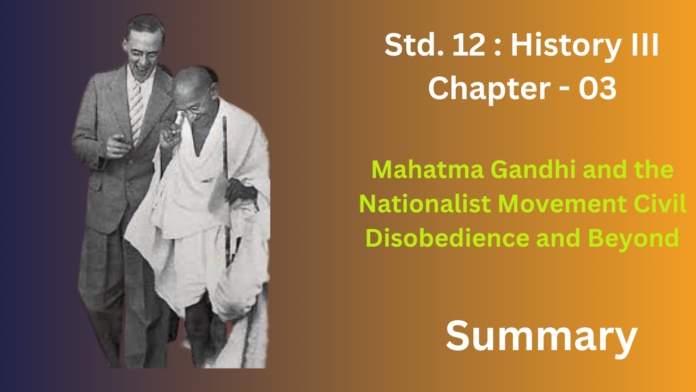“Mahatma Gandhi and the Nationalist Movement: Civil Disobedience and Beyond” examines Gandhi’s leadership during the crucial phase of Indian nationalism, focusing on the Civil Disobedience Movement (1930-1934) and its progression towards the Quit India Movement and independence.
The chapter analyzes the context of Civil Disobedience, including the Great Depression and the Simon Commission’s failure. It details the Salt Satyagraha’s launch, its symbolic power, and broad participation. Strategies of non-violent resistance, the government’s response, and the Gandhi-Irwin Pact’s significance are explored, along with the reasons for the movement’s withdrawal and subsequent nationalist debates. The continued struggle in the late 1930s, the impact of World War II, and the growing demand for complete independence are discussed.
A significant part focuses on the 1942 Quit India Movement, examining its causes, the call for British withdrawal, the widespread but suppressed uprising, and its lasting impact. Finally, the chapter traces the events leading to the 1947 partition and independence, highlighting political negotiations, communalism’s role, and the tragic consequences. It concludes by reflecting on Gandhi’s immense contribution and the complex legacy of independence.
Exercise
1. How did Mahatma Gandhi seek to identify with the common people?
Ans:
Gandhi forged a strong connection with ordinary people through his adoption of the simple dhoti and his practice of spinning khadi, visually reflecting their poverty and promoting the ideal of self-sufficiency. His austere ashram lifestyle and basic diet further resonated with their daily struggles. His growing use of local languages facilitated direct communication, overcoming the traditional gap between the elite and the masses.
By actively involving himself in their concerns, such as the challenges faced by peasants and laborers, and by leading symbolic movements like the Salt Satyagraha, Gandhi demonstrated his deep commitment to their rights and well-being. These varied efforts effectively broke down social barriers, cultivating a profound sense of identification and solidifying his image as their leader and representative.
2. How was Mahatma Gandhi perceived by the peasants?
Ans:
The peasants held an overwhelmingly positive view of Mahatma Gandhi, often seeing him as a savior and a messianic figure with extraordinary abilities to alleviate their suffering and challenge oppressive British rule and local elites.
Across regions, rumors of his divine nature or special powers circulated. They believed he was divinely sent to address their grievances regarding high taxes, forced labor, and exploitation by landlords and officials, even believing he could overrule local authorities and the English monarch.
They affectionately called him by honorifics like “Gandhi Baba,” “Gandhi Maharaj,” or simply “Mahatma,” viewing him as a kind patriarch who understood their hardships and was dedicated to their cause. His simple lifestyle, adoption of the dhoti, and emphasis on manual labor like spinning the charkha deeply resonated with them, symbolizing his solidarity.
Gandhi’s direct involvement in peasant movements like the Champaran and Kheda Satyagrahas further solidified their faith in him. They saw him as a figure who could restore their dignity and autonomy, offering hope for a better future free from oppression.
3. Why did the salt laws become an important issue of struggle?
Ans:
The salt laws became a pivotal point of resistance because salt’s universal necessity made its taxation a tangible hardship for everyone, particularly the poor, generating widespread moral outrage against British rule.
Salt’s symbolic significance in Indian culture, representing sustenance and allegiance, transformed the defiance of these laws into a powerful challenge to British authority and a demand for self-reliance. Gandhi’s Salt Satyagraha effectively mobilized mass participation across all social strata, capturing both national and international attention and eroding British legitimacy through non-violent civil disobedience.
4. Why are newspapers an important source for the study of the national movement?
Ans:
Newspapers were vital for studying the national movement because they spread nationalist ideology, fostering political awareness and unity by articulating grievances and promoting self-governance in various languages. They shaped public opinion and mobilized support by providing platforms for leaders to critique colonial policies and advocate resistance, exposing injustices and urging unity. Newspapers also facilitated communication and coordination among nationalist groups across regions, fostering a shared struggle. Furthermore, they serve as valuable primary sources for historians, offering contemporary accounts and reflecting the evolution of nationalist thought, even considering potential biases and censorship. Lastly, the British government’s repressive actions against nationalist newspapers highlight their significant role in challenging colonial authority and mobilizing the Indian populace, revealing the press’s power as a tool for resistance and social change.
5. Why was the charkha chosen as a symbol of nationalism?
Ans:
Newspapers were vital for studying the national movement because they spread nationalist ideology, fostering political awareness and unity by articulating grievances and promoting self-governance in various languages. They shaped public opinion and mobilized support by providing platforms for leaders to critique colonial policies and advocate resistance, exposing injustices and urging unity. Newspapers also facilitated communication and coordination among nationalist groups across regions, fostering a shared struggle. Furthermore, they serve as valuable primary sources for historians, offering contemporary accounts and reflecting the evolution of nationalist thought, even considering potential biases and censorship. Lastly, the British government’s repressive actions against nationalist newspapers highlight their significant role in challenging colonial authority and mobilizing the Indian populace, revealing the press’s power as a tool for resistance and social change.
6. How was non-cooperation a form of protest?
Ans:
Non-cooperation was a non-violent resistance strategy involving the deliberate withdrawal of Indian support from the British colonial government. Its goal was to cripple the administration by urging Indians to resign from government positions, boycott educational institutions, law courts, and foreign products, and engage in peaceful civil disobedience.
This movement applied both moral and economic pressure on the British, empowered ordinary Indians through widespread involvement, and cultivated unity in opposition to colonial rule. By systematically refusing to collaborate, non-cooperation challenged British authority and legitimacy, establishing itself as a potent instrument in the struggle for independence.
7. Why were the dialogues at the Round Table Conference inconclusive?
Ans:
The absence of the Indian National Congress from the first conference undermined its legitimacy. While they later participated, mistrust and conflicting agendas remained.
Disagreements among Indian delegates were a major obstacle. Religious groups (like the Muslim League), princely states, and other interests often prioritized their own concerns over a unified national vision. Separate electorates for minorities were a key point of contention.
The British government was unwilling to commit to immediate self-governance or dominion status, aiming for a gradual power transfer while protecting British interests. They used Indian divisions to justify their cautious approach and avoid major concessions.
Finally, the changing political climate in Britain and focus on domestic issues limited their willingness for radical reforms. The lack of Indian consensus and British reluctance led to the inconclusive outcomes.
8. In what way did Mahatma Gandhi transform the nature of the national movement?
Ans:
Gandhi transformed the Indian National Movement from an elite endeavor into a mass-based struggle through his relatable lifestyle, attire, and language, mobilizing ordinary Indians on an unprecedented scale and amplifying the movement’s political strength.
He introduced Satyagraha, a philosophy of non-violent resistance rooted in truth and soul force, as the movement’s central method, providing a powerful ethical alternative and enabling widespread participation and moral pressure on the British, exemplified by Non-Cooperation and Civil Disobedience.
Beyond political independence, Gandhi broadened the movement’s agenda to include critical social reforms like ending untouchability, promoting communal harmony, and empowering women. His emphasis on ethical principles and leading by example instilled a profound moral purpose, making the struggle a uniquely transformative force for social and political change under his leadership.
9. What do private letters and autobiographies tell us about an individual? How are these sources different from official accounts?
Ans:
Private letters offer immediate, unfiltered personal thoughts and feelings, revealing daily life, relationships, and intimate insights into character and social context, often differing from public images. Autobiographies are retrospective, subjective narratives shaped by memory and self-presentation, revealing personal interpretations of life and history, though influenced by bias and selective memory.
Official accounts, unlike personal sources, aim for objective documentation of events, policies, and administration from an institutional viewpoint, often prioritizing order and justification. They typically lack the emotional depth, personal stories, and subjective interpretations found in letters and autobiographies, focusing instead on factual reporting and formal processes.
While official records provide institutional perspectives, private letters and autobiographies offer crucial personal viewpoints, revealing individual experiences and motivations often absent in formal accounts. Analyzing both types of sources together enables historians to achieve a more comprehensive and nuanced understanding of the past, balancing institutional narratives with individual human experiences.
10. Find out about the route of the Dandi March. On a map of Gujarat plot the line of the march and mark the major towns and villages that it passed along the route.
Ans:


